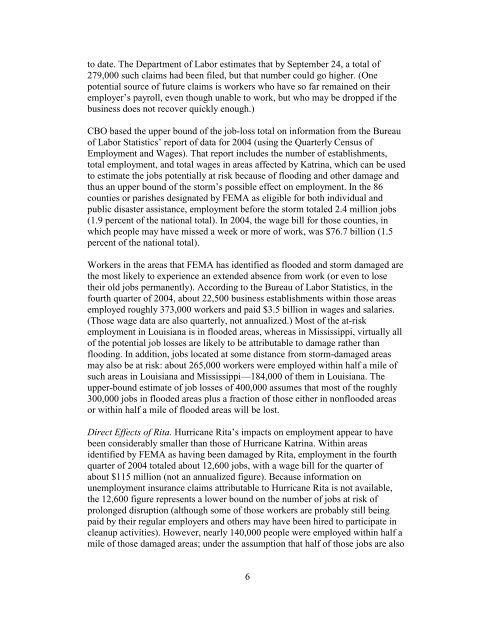Macroeconomic and Budgetary Effects of Hurricanes Katrina and Rita
Macroeconomic and Budgetary Effects of Hurricanes Katrina and Rita
Macroeconomic and Budgetary Effects of Hurricanes Katrina and Rita
Create successful ePaper yourself
Turn your PDF publications into a flip-book with our unique Google optimized e-Paper software.
to date. The Department <strong>of</strong> Labor estimates that by September 24, a total <strong>of</strong><br />
279,000 such claims had been filed, but that number could go higher. (One<br />
potential source <strong>of</strong> future claims is workers who have so far remained on their<br />
employer’s payroll, even though unable to work, but who may be dropped if the<br />
business does not recover quickly enough.)<br />
CBO based the upper bound <strong>of</strong> the job-loss total on information from the Bureau<br />
<strong>of</strong> Labor Statistics’ report <strong>of</strong> data for 2004 (using the Quarterly Census <strong>of</strong><br />
Employment <strong>and</strong> Wages). That report includes the number <strong>of</strong> establishments,<br />
total employment, <strong>and</strong> total wages in areas affected by <strong>Katrina</strong>, which can be used<br />
to estimate the jobs potentially at risk because <strong>of</strong> flooding <strong>and</strong> other damage <strong>and</strong><br />
thus an upper bound <strong>of</strong> the storm’s possible effect on employment. In the 86<br />
counties or parishes designated by FEMA as eligible for both individual <strong>and</strong><br />
public disaster assistance, employment before the storm totaled 2.4 million jobs<br />
(1.9 percent <strong>of</strong> the national total). In 2004, the wage bill for those counties, in<br />
which people may have missed a week or more <strong>of</strong> work, was $76.7 billion (1.5<br />
percent <strong>of</strong> the national total).<br />
Workers in the areas that FEMA has identified as flooded <strong>and</strong> storm damaged are<br />
the most likely to experience an extended absence from work (or even to lose<br />
their old jobs permanently). According to the Bureau <strong>of</strong> Labor Statistics, in the<br />
fourth quarter <strong>of</strong> 2004, about 22,500 business establishments within those areas<br />
employed roughly 373,000 workers <strong>and</strong> paid $3.5 billion in wages <strong>and</strong> salaries.<br />
(Those wage data are also quarterly, not annualized.) Most <strong>of</strong> the at-risk<br />
employment in Louisiana is in flooded areas, whereas in Mississippi, virtually all<br />
<strong>of</strong> the potential job losses are likely to be attributable to damage rather than<br />
flooding. In addition, jobs located at some distance from storm-damaged areas<br />
may also be at risk: about 265,000 workers were employed within half a mile <strong>of</strong><br />
such areas in Louisiana <strong>and</strong> Mississippi—184,000 <strong>of</strong> them in Louisiana. The<br />
upper-bound estimate <strong>of</strong> job losses <strong>of</strong> 400,000 assumes that most <strong>of</strong> the roughly<br />
300,000 jobs in flooded areas plus a fraction <strong>of</strong> those either in nonflooded areas<br />
or within half a mile <strong>of</strong> flooded areas will be lost.<br />
Direct <strong>Effects</strong> <strong>of</strong> <strong>Rita</strong>. Hurricane <strong>Rita</strong>’s impacts on employment appear to have<br />
been considerably smaller than those <strong>of</strong> Hurricane <strong>Katrina</strong>. Within areas<br />
identified by FEMA as having been damaged by <strong>Rita</strong>, employment in the fourth<br />
quarter <strong>of</strong> 2004 totaled about 12,600 jobs, with a wage bill for the quarter <strong>of</strong><br />
about $115 million (not an annualized figure). Because information on<br />
unemployment insurance claims attributable to Hurricane <strong>Rita</strong> is not available,<br />
the 12,600 figure represents a lower bound on the number <strong>of</strong> jobs at risk <strong>of</strong><br />
prolonged disruption (although some <strong>of</strong> those workers are probably still being<br />
paid by their regular employers <strong>and</strong> others may have been hired to participate in<br />
cleanup activities). However, nearly 140,000 people were employed within half a<br />
mile <strong>of</strong> those damaged areas; under the assumption that half <strong>of</strong> those jobs are also<br />
6
















